
A hamadryad or hamadryas is a Greek mythological being that lives in trees. It is a particular type of dryad which, in turn, is a particular type of nymph. Hamadryads are born bonded to a certain tree on which its life depends. Some maintain that a hamadryad is the tree itself, with a normal dryad being simply the indwelling entity, or spirit, of the tree. If the tree should die, the hamadryad associated with it would die as well. For this reason, both dryads and the other gods would punish mortals who harmed trees.
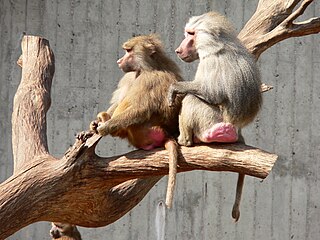
The hamadryas baboon is a species of baboon within the Old World monkey family. It is the northernmost of all the baboons, being native to the Horn of Africa and the southwestern region of the Arabian Peninsula. These regions provide habitats with the advantage for this species of fewer natural predators than central or southern Africa where other baboons reside. The hamadryas baboon was a sacred animal to the ancient Egyptians and appears in various roles in ancient Egyptian religion, hence its alternative name of 'sacred baboon'.

The Guinea baboon is a baboon from the Old World monkey family. Some (older) classifications list only two species in the genus Papio, this one and the hamadryas baboon. In those classifications, all other Papio species are considered subspecies of P. papio and the species is called the savanna baboon.

A harem is an animal group consisting of one or two males, a number of females, and their offspring. The dominant male drives off other males and maintains the unity of the group. If present, the second male is subservient to the dominant male. As juvenile males grow, they leave the group and roam as solitary individuals or join bachelor herds. Females in the group may be inter-related. The dominant male mates with the females as they become sexually active and drives off competitors, until he is displaced by another male. In some species, incoming males that achieve dominant status may commit infanticide.
Hamadryas was a nymph, the mother of the hamadryads in Greek mythology, and the name has been used repeatedly in scientific naming and may refer to:

Cracker butterflies are a Neotropical group of medium-sized brush-footed butterfly species of the genus Hamadryas. They acquired their common name due to the unusual way that males produce a "cracking" sound as part of their territorial displays. The most comprehensive work about their ecology and behavior is that of Julian Monge Najera et al. (1998). The genus was erected by Jacob Hübner in 1806.
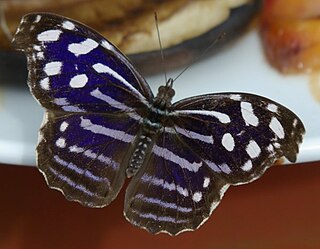
Biblidinae is a subfamily of nymphalid butterflies that includes the tropical brushfoots. This subfamily was sometimes merged within the Limenitidinae, but they are now recognized as quite distinct lineages. In older literature, this subfamily is sometimes called Eurytelinae.

Hamadryas argentea, the silvery buttercup, is a species of plant in the family Ranunculaceae. It is endemic to Falkland Islands. Its natural habitats are temperate dwarf shrub heath and temperate grassland.

Tellervini is a tribe of danaid butterflies with only the one genus Tellervo, with six widely distributed species found in the Australasian realm and the Indomalayan realm. The taxon is apparently monophyletic, but its relationship with the other two danaid tribes is yet uncertain. The phylogeography of the group is also a challenge to those who hold to a Cenozoic origin of the butterflies.

Baboons are primates comprising the genus Papio, one of the 23 genera of Old World monkeys, in the family Cercopithecidae. There are six species of baboon: the hamadryas baboon, the Guinea baboon, the olive baboon, the yellow baboon, the Kinda baboon and the chacma baboon. Each species is native to one of six areas of Africa and the hamadryas baboon is also native to part of the Arabian Peninsula. Baboons are among the largest non-hominoid primates and have existed for at least two million years.
Bulbophyllum hamadryas is a species of orchid in the genus Bulbophyllum.

Hamadryas amphinome, the red cracker, is a species of cracker butterfly in the family Nymphalidae, native to regions of North and South America.

Hamadryas arinome, the turquoise cracker, is a species of cracker butterfly in the family Nymphalidae. The species was first described by Hippolyte Lucas in 1853. It is found from Mexico south to the Amazon basin.
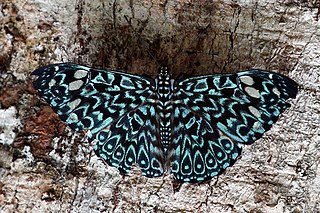
Hamadryas belladonna, the belladonna cracker, is a species of cracker butterfly in the family Nymphalidae. It is endemic to Brazil.
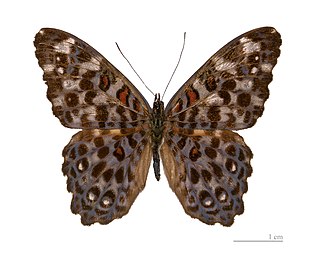
Hamadryas chloe, the Chloe cracker, is a species of cracker butterfly in the family Nymphalidae. It is found in Suriname, Peru, Colombia, Bolivia, and Brazil.
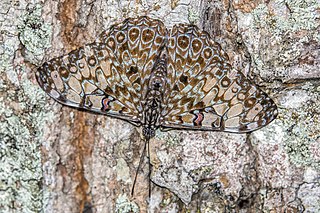
Hamadryas feronia, the blue cracker or variable cracker, is a species of cracker butterfly in the family Nymphalidae. It is found in the southern parts of North America and South America and southwards Brazil.
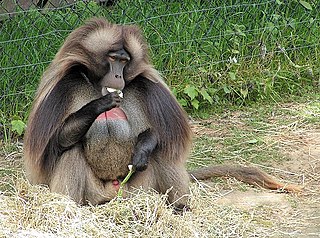
One-male groups are a type of social organization where one male interacts with a group of females and their immature offspring. Offspring of both sexes are evicted from the group upon reaching puberty. It can be seen in many species of primates, including the gelada baboon, the patas monkey, savanna baboon, sun-tailed monkey, golden snub-nosed monkey, and the hamadryas baboon. There are costs and benefits for individuals living in one-male groups. As well, individuals within one-male groups can interact with each other just like individuals can interact with those from different one-male groups.
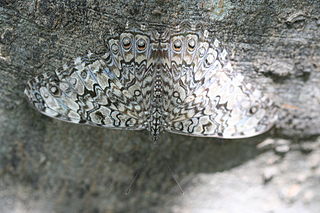
Hamadryas februa, the graycracker, is a species of cracker butterfly in the family Nymphalidae. It is found from Argentina north through tropical America to Mexico. Rare strays can be found up to the lower Rio Grande Valley in southern Texas. The habitat consists of subtropical forests, forest edges and cultivated areas with trees.

Hamadryas is a genus of flowering, perennial herbs in the family Ranunculaceae. It is found in the southernmost regions of Chile and Argentina, as well as the Falkland Islands, predominantly in alpine and sub-alpine habitats. The range of one species, Hamadryas delfinii, extends north into San Juan Province, Argentina.

Hamadryas glauconome, the pale cracker or glaucous cracker, is a species of cracker butterfly in the family Nymphalidae. It was described by Henry Walter Bates in 1864 and is found in Mexico, Central America and south to Peru. It has been recorded as an unexpected vagrant in the United States in southern Florida, Arizona and Texas.

















